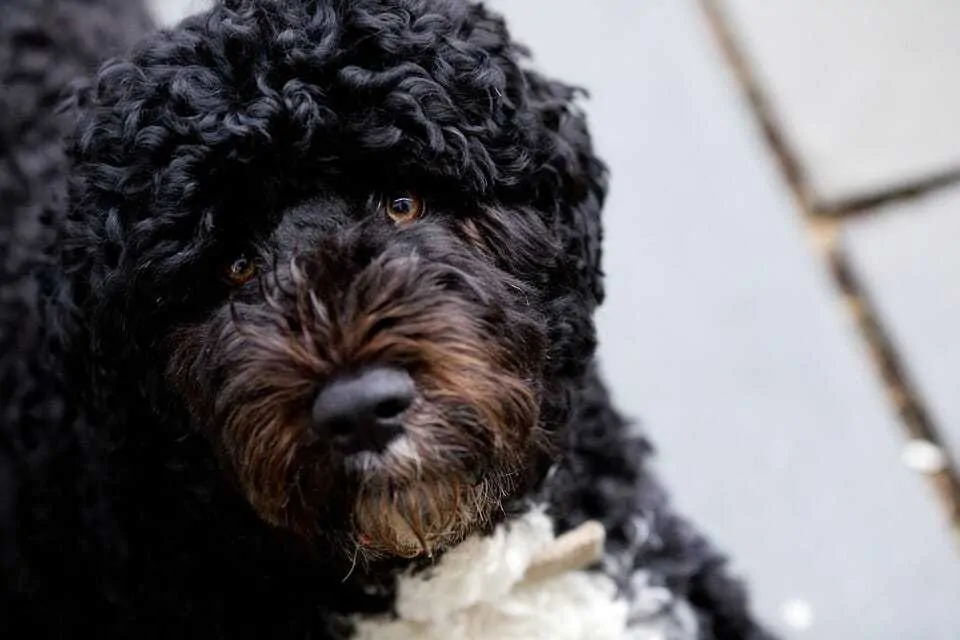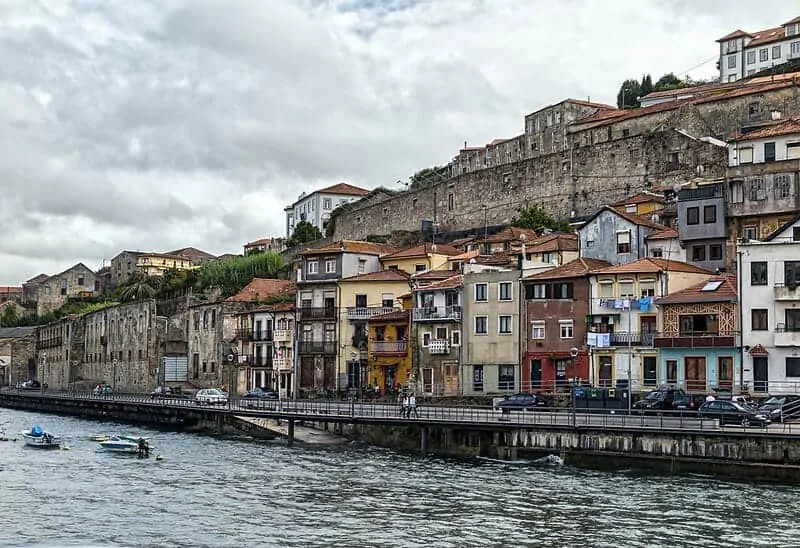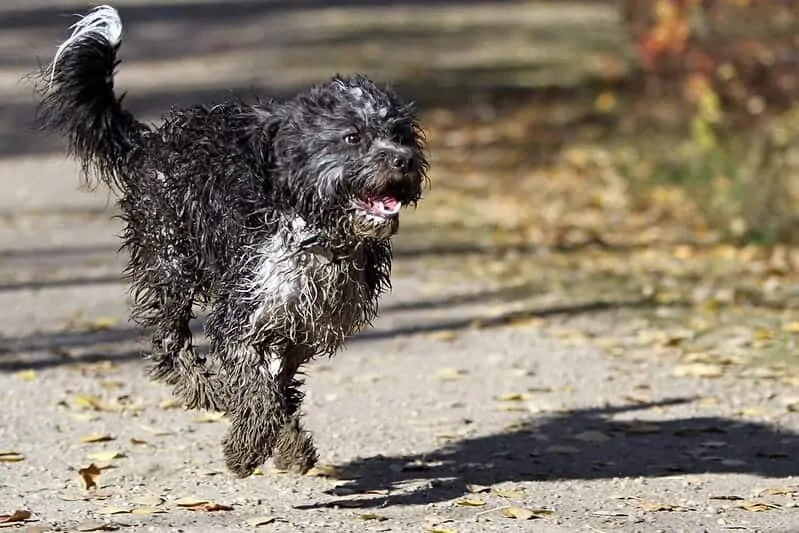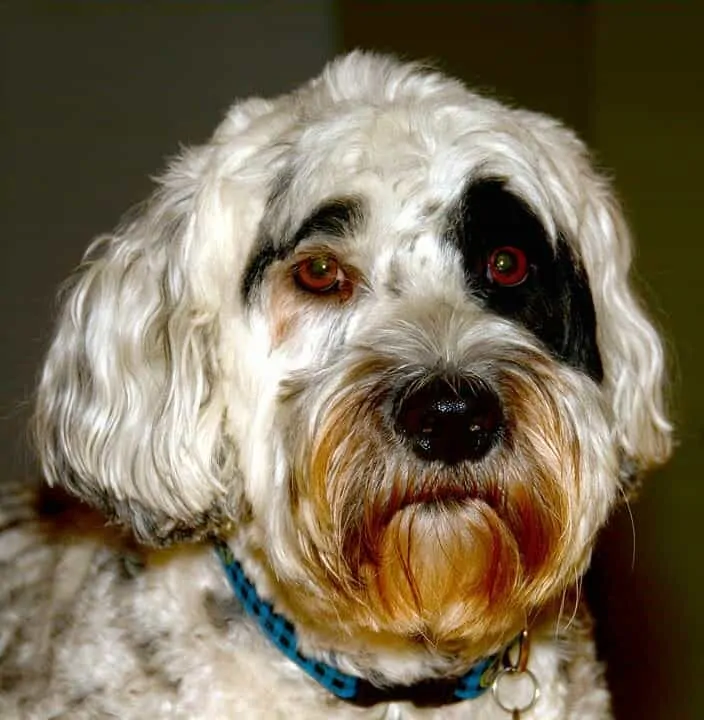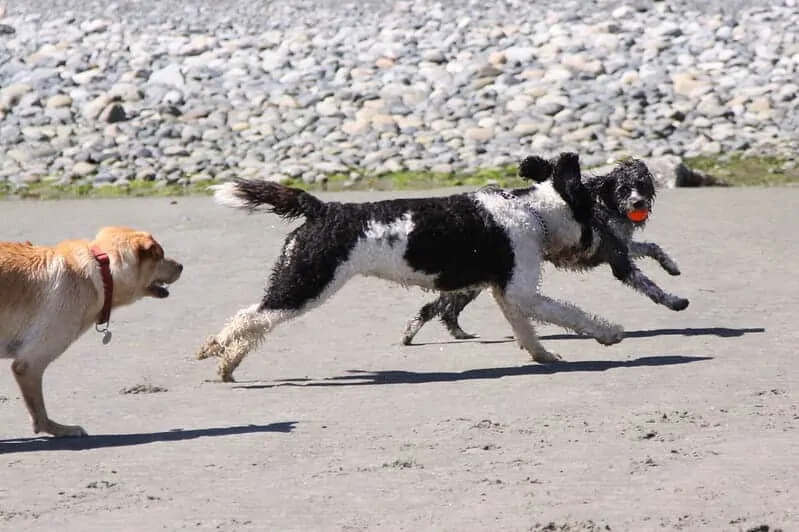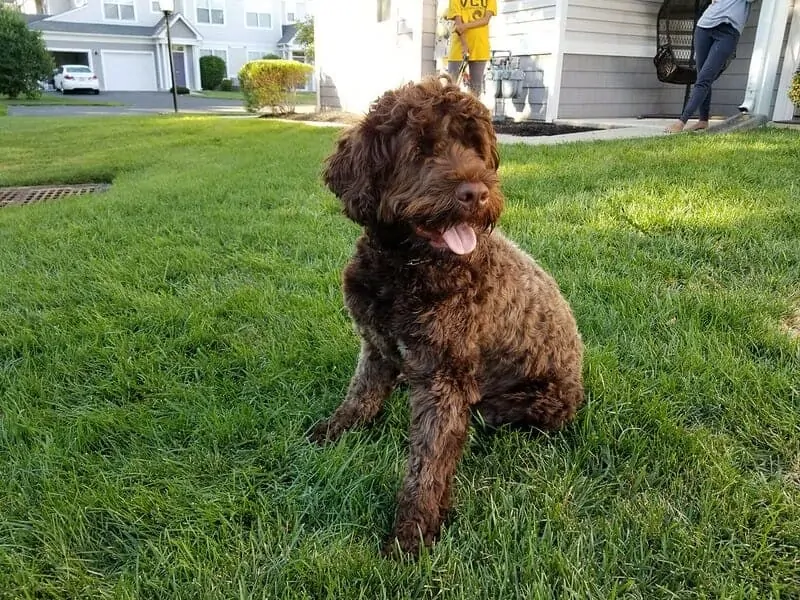This curly-coated dog’s spunk and affection have owners around the globe swooning. The Portuguese Water Dog is as intelligent as they are loving and fit for active families that can give them the exercise and attention they desire. But this fluffy pup with a long working history isn’t for everyone.
Keep reading to find out if the Portuguese Water Dog is the right kind of pooch to add to your family.
Contents
General Characteristics of the Portuguese Water Dog
Other names: Algarve water dog
Height
17 to 23 inches
Weight
35 to 60 pounds
Lifespan
11 to 14 years
Origin
Portugal
Colors
Black, brown, black or brown with white markings
Grooming needs
High
Activity level: Medium
Best suited for: Attentive owners and families
While their personality and coat are similar to the poodle’s, the Portuguese water dog is a much sturdier canine with a bulkier build and thicker legs. Their reputation as strong swimmers in any type of water gained them popularity with fishermen throughout Spain and Portugal.
The History of the Portuguese Water Dog
There were curly coated water dogs in Portugal as far back as the 13th century. Historical literature describes them as black dogs with rough coats and tufts at the end of their tails.
While this certainly seems an apt description of a modern-day Portuguese water dog, it is impossible to tell when the PWD bloodline split from the ancestors of other curly water dogs common in Europe such as the poodle and Irish water spaniel.
What we do know, is that fishermen in the Algarve region frequently used these dense, medium-sized water dogs to help them retrieve fishing nets and gear, swim messages and items between ships and from ships to shore, and to otherwise accompany fishermen on long journeys out to sea. It is even said that the Portuguese Water Dog was trained to herd fish into nets.
With webbed feet, a waterproof coat, and a strong work ethic, it wasn’t long until the Algarve water dog was a common sight all along the Portuguese coast.
But their popularity began to fall in the 1930s. That’s when a Portuguese shipping magnate named Vasco Bensuade began efforts to save the breed from the brink of extinction. He searched up and down the coast for PWDs and brought those worthy of breeding back to his kennel.
He was so successful in producing litters, that his stud dog Leão’s genes can be found in almost half of all Portuguese water dogs alive today.
The Portuguese water dog was a common sight on the Portugal coast where they were utilized by fishermen and the navy. “OPORTO Y DUERO – PORTO Y DOURO” by Miquel Fabre / CC BY-NC-ND 2.0
Another Portuguese man named Antonio Cabral continued Bensuade’s work in the 1950s and was key in establishing the breed in the United States. In 1972 a group of PWD owners formed the Portuguese Water Dog Club of America. Here, they brought together both lines of PWDs to create a more diverse genetic pool on which they could grow the breed.
Today’s Portuguese Water Dog rarely finds itself performing these original jobs, though still loves the water and retrieving. They’re intelligence and work ethic, however, is still frequently called upon for use as service dogs for the hearing impaired, therapy dogs, and as search and rescue dogs.
But for most Portuguese water dogs, their only job is to be a loving companion to a doting family. And that’s something this breed is especially good at.
The Temperament of the Portuguese Water Dog
Centuries cooped up on fishing vessels with their owners has turned the once stoic work-hound into an affection seeking ball of fluff.
Portuguese Water Dogs really enjoy the attention of their families and need to be close to their people as often as possible. They don’t do well being left at home alone for long periods and will seek out anyone, including strangers to dote on them.
>>>Dealing with a clingy fido? Here are some tips to fight separation anxiety.
While Portuguese Water Dogs will typically alert to someone new coming on the property, these dogs are usually happy to see anyone. Their bountiful energy and spring-loaded legs mean most visitors are greeted with a leap and a lick to the chops.
This athletic dog loves to run and swim and is happiest spending the day with their family at the park or in the backyard. “2011-10-15 Laurier Off-Leash Dog Park” by Sangudo / CC BY-NC-ND 2.0
That same energy is the reason PWDs, especially adolescent and young dogs, need a lot of exercise. A long daily walk is a good start, but the dog breed will especially benefit from a day at dog daycare, a hike, or a long game of fetch.
Because these dogs are highly intelligent, the dog breed also requires a lot of mental stimulation to keep them from becoming destructive. The dog breed is a great candidate for trick training as well as therapy dog work. The dog breed has also become a common sight in agility rings and flyball and dock diving competitions.
>>>Swimming is a great exercise for dogs. Here are more great ways to keep your pup active.
Overall, the Portuguese Water Dog is a happy dog who craves attention and does not do well away from their owners. They will try to curl up in your lap for endless pets if you let them but need an appropriate outlet for all their energy.
Health Issues Common to the Portuguese Water Dog Breed
There have been multiple points in the PWD’s history where the population has dropped, leading to a reduced genetic load. This has led to a few health problems within the breed. Luckily, responsible breeders are working hard to reduce the appearance of many of these issues today.
Here are a few of the more common health issues that can be found in the Portie.
- Hip dysplasia
- Juvenile dilated cardiomyopathy
- GM-1 storage disease
- Follicular dysplasia (hair loss)
- Progressive retinal atrophy
- Cataracts
- Distichiasis
- Addison’s disease
- Inflammatory bowel disease
- Lymphangiectasia
- Megaesophagus
While most breed standards require white markings to cover less than 30% of the body, companion Portuguese Water Dog owners have taken a special interest in “party” colored dogs. As a result, dogs with these unique markings are becoming more commonplace.
GM-1 storage disease is one of the more unique health issues that has plagued the Portuguese Water Dog breed. An affected dog possesses a gene mutation that results in abnormal storage of acidic lipid materials within the cells of the nervous system. As this disease progresses, nerve cells, especially those found in the brain, begin to die.
For Portuguese water dogs with the condition, problems usually become apparent around six months of age. Sudden onset of ataxia, tremors, seizures, and eye lesions may be seen, while other dogs will only show behavioral changes. However, many dogs do not show any symptoms at all.
This disease is always fatal. Owners of dogs suffering from the condition may find their dog has passed away without any warning or clue as to what happened.
Luckily, genetic testing by responsible breeders has led to fewer and fewer PWDs meeting this fate. While the genetic mutation is still commonly seen in the breed, the disease will only develop if a puppy inherits a copy from each parent. By testing breeding dogs and only breeding effected individuals to those who do not have the mutation, breeders can guarantee that none of the puppies will develop the disease.
This is just one of many reasons it is important to research your breeder before you commit to purchasing a Portie puppy. In addition to testing for the GM-1 mutation, ethical breeders will also have their dog’s eyes and hips evaluated and have both parents tested to see if they are carriers for juvenile dilated cardiomyopathy.
If you would rather not roll the dice on one of these early fatal diseases, you can always look into adopting an adult Portie in need of a home. Check with your local PWD rescue for available dogs.
Check out the above video to see some adorable Porties in action.
Do Portuguese Water Dogs Do Well With Children and Other Pets?
Porties are social creatures by nature and this love of attention often extends to children and babies.
As long as they are socialized with a variety of people in puppyhood, the Portuguese Water Dog is a great choice for families with children. The dog breed enjoys cuddling almost as much as they do running around the backyard playing fetch or chase. The dog breed can be over-excitable at times, which can lead to them playing too rough with younger kids, so supervision is always a must.
Their gentle nature and need for close contact also make these dogs a great choice for children suffering from physical or behavioral disabilities that would benefit from a service dog or companion. Many are trained as seizure alert dogs, service dogs for the hearing impaired, and as general therapy dogs.
In general, the PWD’s sociable nature extends beyond their love of humans. Most enjoy the company of other dogs and are great candidates for multidog households and for doggy daycare. They are a playful and funloving dog breed and rarely aggressive with other dogs or animals.
The dog breed also makes good companions for cats and other small pets. Of course, early socialization and training is a must if you expect to run a peaceful household with multiple animals, no matter what type they are.
The PWD is a fun-loving hound who typically enjoys the company of other dogs, pets and people. “2011 Nanaimo” by Sangudo / CC BY-NC-ND 2.0
What to Consider Before Bringing Home a Portuguese Water Dog
Think you have what it takes to provide the right home for a Portie? Here are a few more things to consider before you commit,
PWD Activity Level
Like all working breeds, Portuguese Water Dogs have a high energy level and need to be provided a positive outlet for it. Long walks, hikes, and extended games of fetch at the park are all great ways to tire out an adult Portie. Adolescent dogs may need even more attention though. Getting your dog started early in dog sports like agility or flyball is one way to get rid of excess energy and spend quality time together.
While therapy work like visiting hospitals or schools isn’t physically draining, it is a great way to keep your Portuguese Water Dogs mentally stimulated and provide them with the showering of attention the dog breed desires.
PWD Trainability
These are smart dogs that want very much to please. But it is important to start training early on to establish good boundaries and habits before your dog becomes a teenager. PWDs respond best to positive training techniques and are especially motivated by praise and pets. Consistency is key, but being too hard on them or resorting to punitive methods is likely to only damage your relationship and cause more behavior issues.
These dogs are especially good candidates for trick training given their intelligence and physical abilities. This is also a great way to wear them out mentally and spend time with them.
The Portuguese water dog’s thick, waterproof curly coat makes this dog a good choice for owners in a variety of climates. Though, that same coat requires a lot of energy to maintain.
PWD Grooming
The Portuguese water dog comes in two coat types: curly and wavy. Both types of hair will continue to grow until cut, so appointments at the groomers every two months is a must. Without proper care, either coat is likely to get tangled and matted which can cause serious skin irritation. Most PWD owners opt for the retriever cut (a uniform grooming leaving about one inch of hair all over the body) but some still prefer the traditional PWD cut with longer hair left on the front end and a close cut on the back end with a puff left at the end of the tail.
>>>Learn what different grooming terms mean before your next trip to the groomers.
In addition to the time and money needed for professional grooming, you will also need to spend time brushing out their coat at least a few times a week. And, like all dogs, the dog breed will need their nails trimmed about every six weeks.
PWD Nutrition
Porties will do well on any quality dog food meant for medium active breeds. While the dog breed usually has the energy to burn through a lot of calories, it is important to monitor their weight and prevent overeating. This can be tough, especially for dogs that have such a fluffy coat. Make sure to work with your vet to set weight goals for your pup and to determine if adjustments need to be made to their feeding routine.
While black is the most common coat color for the Portuguese water dog, the dog breed can also come in solid brown or brown with white markings. “Chewie the Portuguese Water Dog” by Ely Christman / CC BY 2.0
Cost
These fluffy pups have been gaining popularity over the last couple of decades, but are still somewhat rare. That is one reason a purebred Portie pup will cost you around $2,500, well over average. Of course, the extra price is worth it to make sure you are getting a dog from a responsible breeder with the breed’s overall health in mind.
Beyond the initial investment, this medium-sized breed is fairly easy to care for and shouldn’t cost much more than the average dog to own. You will need to budget some extra cash for bi-monthly grooming and may want to set aside some funds for dog daycare during the early years.
10 Fun Facts About the Portuguese Water Dog
Now that you know what it takes to own a Portuguese water dog, here are some fun facts about the breed.
- PWDs can be all black or brown or have small patches of white. But recently, “party” Porties that are mostly white with patches fo color have become more popular.
- President Barack Obama owned two PWDs, Bo and Sunny, during his term.
- PWDs can have tightly curled coats like poodles or longer, wavier hair.
- These dogs do not shed and can be a good choice for some people with dog allergies.
- The dog breed was used by the Spanish armada to carry messages between vessels.
- The San Fransisco Giant’s baseball team employed a troop of PWDs to retrieve home run balls that landed in the bay during games.
- The traditional PWD groom was meant to reduce the shock of cold water on the front of the body while leaving the hind end free to maneuver while the dog breed swam.
Senator Ted Kennedy has always loved PWDs and he shared that love with the Obamas by gifting them Bo during the President’s term in the White House.
- Like most water retrievers, the dog breed has webbed feet to help them swim.
- A Portuguese monk wrote an account of a black, rough-coated dog with a tail tuft who saved a drowning sailor off the coast in 1297.
- Though they are typically quiet dogs, the dog breed has a multi-octave voice capable of producing a wide range of strange whines, whimpers, barks, and howls.
Before You Go
Not sure the PWD is the right dog for you? Here are some other breeds to consider.

Sara Seitz has spent most of her life in the pet industry and has a bachelors in animal behavior from Colorado State University. Sara started working with dogs and cats as a high schooler at a rural boarding kennel. There she learned a lot about the bad and the ugly of the pet service industry. But not even the toughest day at that job would dissuade Sara from following her dream of working with animals.
In college, Sara got a job at a dog daycare and boarding facility in Fort Collins, Colorado. Her new career provided even more opportunities for learning about dog behavior than her classes did. As general manager of the daycare, Sara helped the company launch a new in-home pet sitting branch and trained to become a certified dog trainer. Between shifts taking care of peoples pets in-home and supervising dogs during playtime at the daycare, Sara organized and taught obedience classes.
Sara has always been passionate about bettering the lives of our canine companions. She soon found that advocating for and educating owners in the power of positive reinforcement training was one of the best ways to help dogs and their owners live happier lives.
